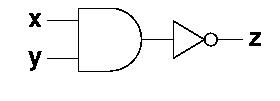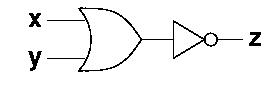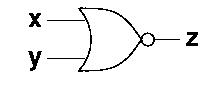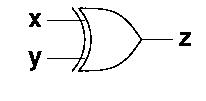Gates
Introduction
The basic building blocks of a computer are called logical
gates or just gates.
Gates are basic circuits that have at least one (and usually more)
input and exactly one output. Input and output values are
the logical values true and false. In computer
architecture it is common to use 0 for false and 1
for true. Gates have no memory. The value of the output
depends only on the current value of the inputs. This fact makes it
possible to use a truth table to fully describe the behavior
of a gate.
We usually consider three basic kinds of gates, and-gates,
or-gates, and not-gates (or inverters).
Basic gates
The and-gate
An and-gate has an arbitrary number of inputs. The output
value is 1 if and only if all of the inputs are
1. Otherwise the output value is 0. The
name has been chosen because the output is 1 if and only
if the first input and the second input, and, ...,
and the nth input are all 1.
It is often useful to draw diagrams of gates and their
interconnections. In such diagrams, the and-gate is drawn like
this:

The truth table for an and-gate with two inputs looks like
this:
x y | z
-------
0 0 | 0
0 1 | 0
1 0 | 0
1 1 | 1
The or-gate
Like the and-gate, the or-gate can have an arbitrary
number of inputs. The output value is 1 if and only of
at least one of the input values are 1.
Otherwise the output is 0. In other words, the output
value is 0 only if all inputs are 0. The
name has been chosen because the output is 1 if and only
if the first input or the second input, or, ...,
or the nth input is 1.
In circuit diagrams, we draw the or-gate like this:

The truth table for an or-gate with two inputs looks like
this:
x y | z
-------
0 0 | 0
0 1 | 1
1 0 | 1
1 1 | 1
The inverter
An inverter has exactly one input and one output. The value
of the output is 1 if and only if the input is 0.
Otherwise, the output is 0. In other words, the value of the
output is the exact opposite of the value of the input.
In circuit diagrams, we draw the inverter like this:

The truth table for an inverter looks like this:
x | y
-----
0 | 1
1 | 0
Combined gates
Sometimes, it is practical to combine functions of the basic gates
into more complex gates, for instance in order to save space in circuit
diagrams. In this section, we show some such combined gates together
with their truth tables.
The nand-gate
The nand-gate is an and-gate with an inverter on the
output. So instead of drawing several gates like this:

We draw a single and-gate with a little ring on the output
like this:

The nand-gate, like the and-gate can take an
arbitrary number of inputs.
The truth table for the nand-gate is like the one for the
and-gate, except that all output values have been inverted:
x y | z
-------
0 0 | 1
0 1 | 1
1 0 | 1
1 1 | 0
The nor-gate
The nor-gate is an or-gate with an inverter on the
output. So instead of drawing several gates like this:

We draw a single or-gate with a little ring on the output
like this:

The nor-gate, like the or-gate can take an
arbitrary number of inputs.
The truth table for the nor-gate is like the one for the
or-gate, except that all output values have been inverted:
x y | z
-------
0 0 | 1
0 1 | 0
1 0 | 0
1 1 | 0
The exclusive-or-gate
The exclusive-or-gate is similar to an or-gate. It
can have an arbitrary number of inputs, and its output value is
1 if and only if exactly one input is
1 (and thus the others 0). Otherwise, the
output is 0.
We draw an exclusive-or-gate like this:

The truth table for an exclusive-or-gate with two inputs looks
like this:
x y | z
-------
0 0 | 0
0 1 | 1
1 0 | 1
1 1 | 0
So, how many different types of gates are there?
A valid question at this point is how many different kinds of gates
there are, and what they are called.
Let us limit ourselves to gates with n inputs. The truth
tables for such gates have 2n lines. Such a gate
is completely defined by the output column in the truth table. The
output column can be viewed as a string of 2n
binary digits. How many different strings of binary digits of length
2n are there? The answer is
22n, since there are
2k different strings of k binary digits,
and if k=2n, then there are
22n such strings. In particular, if
n=2, we can see that there are 16
different types of gates with 2 inputs.
Most of these gates do not have any names, and indeed, most of them
are quite useless. For completeness, let us look at all
16 and study the functions they compute. Each entry in
the following table is specified by the output string:
- 0000 A gate that ignores both its inputs and
always gives 0 on the output. This gate does not
require any circuits. Just let the inputs hang and connect the
output to a 0.
- 0001 This is the and-gate described
above.
- 0010 This is like an and-gate with an
inverter on the second input.
- 0011 This gate ignores its second input, and gives
as output the value of its first input. It does not require any
circuits. Just connect the output to the first input and let the
second input hang.
- 0100 This is like an and-gate with an
inverter on the first input.
- 0101 This gate ignores its first input, and gives
as output the value of its second input. It does not require any
circuits. Just connect the output to the second input and let the
first input hang.
- 0110 This is the exclusive-or-gate described
above.
- 0111 This is the or-gate described
above.
- 1000 This is the nor-gate described
above.
- 1001 This is like an exclusive-or-gate
with an inverter on its output.
- 1010 This gate can be built with an
inverter on the second input, and with the first input
hanging.
- 1011 This is like an or-gate with an
inverter on its second input.
- 1100 This gate can be built with an
inverter on the first input, and with the second input
hanging.
- 1101 This is like an or-gate with an
inverter on its first input.
- 1110 This is the nand-gate described
above.
- 1111 This is a gate that ignores both its inputs
and always gives a 1 as output. This gate does not
require any circuits. Just let the inputs hang and connect the
output to a 1.
As you can see, most of the gates possible, are quite useless.
Doing it all with only one kind of gate
As it turns out, it is possible to build any kind of gate using only
nand-gates. To see this, first observe that an
inverter is just a nand-gate with only one input.
Second, an and-gate can be built as a nand with an
inverter on its output. Last, an or-gate can be build with
a nand-gate with an inverter on each input.
In some circuit technology, it is actually easier to build a
nand-gate than any of the other gates. In that case, the
nand-gate is considered the most primitive building block,
and everything else is built from it.
Similarly, all gates can be realized from only nor-gates.
Again an inverter is just a nor-gate with only one
input. An or-gate is a nor-gate with an
inverter on its output, and an and-gate is just a
nor-gate with an inverter on each input.
Summary
Although gates can be arbitrarily complicated, from now on when we say
gates we mean one of inverter, and,
or, nand, nor, and sometimes exclusive
or.
So why do we want to exclude other gates? The main reason is that we
want the number of gates of a circuit to reflect the cost of
fabrication of that circuit. If we allow arbitrarily complicated
gates, we can design an arbitrarily complicated combinatorial circuit
with only one gate.
Our restriction above is not ideal, since in order for the number of
gates to reflect the cost, we would have to take the particular
technology used for fabrication into account. Different circuits are
easy to make in different technologies. But in order to remain
somewhat independent of specific technology, we use this
approximation.








